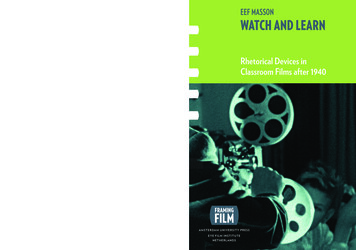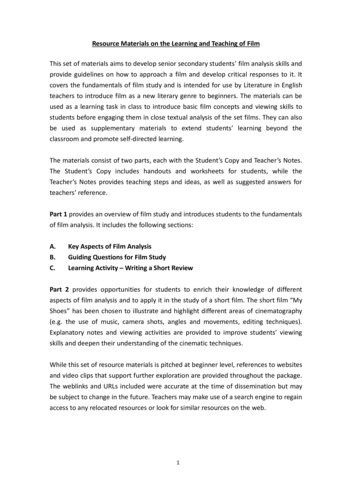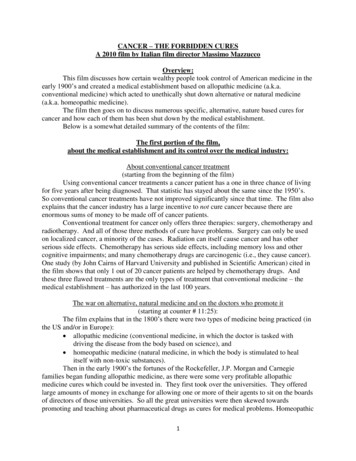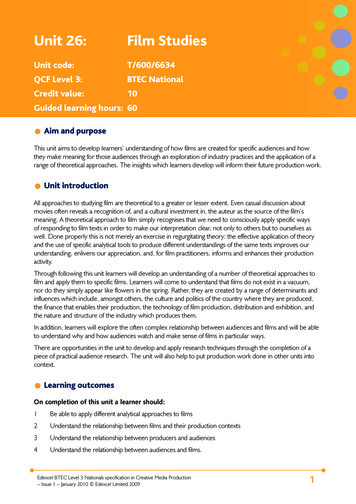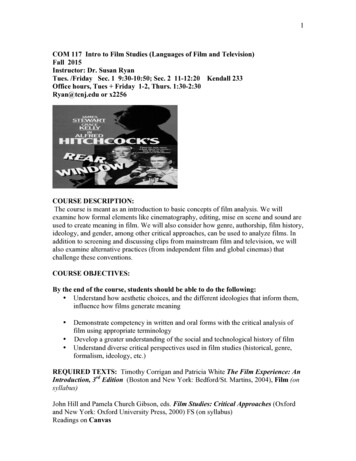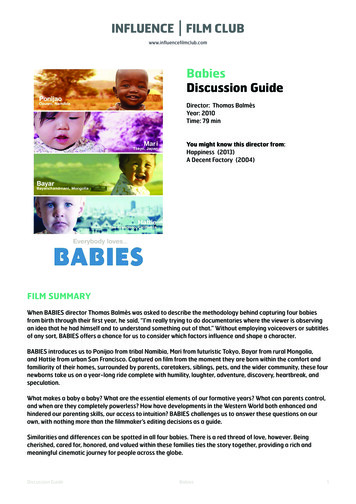
Transcription
www.influencefilmclub.comBabiesDiscussion GuideDirector: Thomas BalmèsYear: 2010Time: 79 minYou might know this director from:Happiness (2013)A Decent Factory (2004)FILM SUMMARYWhen BABIES director Thomas Balmès was asked to describe the methodology behind capturing four babiesfrom birth through their first year, he said, “I’m really trying to do documentaries where the viewer is observingan idea that he had himself and to understand something out of that.” Without employing voiceovers or subtitlesof any sort, BABIES offers a chance for us to consider which factors influence and shape a character.BABIES introduces us to Ponijao from tribal Namibia, Mari from futuristic Tokyo, Bayar from rural Mongolia,and Hattie from urban San Francisco. Captured on film from the moment they are born within the comfort andfamiliarity of their homes, surrounded by parents, caretakers, siblings, pets, and the wider community, these fournewborns take us on a year-long ride complete with humility, laughter, adventure, discovery, heartbreak, andspeculation.What makes a baby a baby? What are the essential elements of our formative years? What can parents control,and when are they completely powerless? How have developments in the Western World both enhanced andhindered our parenting skills, our access to intuition? BABIES challenges us to answer these questions on ourown, with nothing more than the filmmaker’s editing decisions as a guide.Similarities and differences can be spotted in all four babies. There is a red thread of love, however. Beingcherished, cared for, honored, and valued within these families ties the story together, providing a rich andmeaningful cinematic journey for people across the globe.Discussion GuideBabies1
www.influencefilmclub.comFILM THEMESLife is a universal concept. When viewed through the eyes of variouscultures, the manner in which life is lived may diverge, but the powersinherent in each individual connect us across the globe.UNIVERSALITY OF LIFERural, urban, developed, developing: the first year of life in a Mongolianyurt is different than one spent in a high-rise apartment in Tokyo.But fundamentally, we are all the same. Each baby reaches the samemilestones of smiling, crawling, babbling, or grabbing at similar timesregardless of the language they hear, the food they consume, or thestimulus to which they are exposed. They are all preoccupied with thesame daily needs of sustenance, comfort, and love. Once an individual’sbasic needs are met, the miracles of life unfold for everyone, no matterwhere they live in this world.EXTERNAL WORLD, INTERNAL SELFCaretakers can control some of the external factors that influence thechildren under their care. Placing or removing certain objects, providingnutrition, passing on one’s interpretation of life through actions or byintervening at difficult crossroads, parents often set out to steer theirchildren in a certain direction, yet so much remains beyond their control.Each individual is born with a spirit that is arguably unique. BABIESoffers visual proof that the primary role of a parent is to not silence thesongbird within each infant, but to provide a stable foundation on whicheach baby can find their own singular path.BUSY VS. BOREDOMBoredom is the antithesis of the modern, developed world and isoften equated with failure, inability, and a lack of creativity. Busy isthe keyword of our days, and in BABIES, this translates into toys andclasses, distractions, interactions, a constant stream of stimuli providedby parents who are always on the go. This busyness, however, has notyet plagued the developing world, which relies on the age-old notionof passive time, acknowledging the buzzing of a bee, the sensation of astone, or the humdrum of the midday hour as learning tools. For babieswho are given blocks of unscheduled time, happiness sometimes seemsmore readily theirs.OVER VS. UNDER PROTECTEDPonijao chewed on a dirt-covered bone. Bayar climbed naked on arusty barrel in a field of roaming cows. A First-Worlder might ask, Wherewere their parents? Where is this child’s safety net and protection? Butconsider this: there are negative implications to overprotection. Somechildren are never granted the freedom to make their own mistakes,but are hovered over and guided through pre-selected experiences.Parents in the developing world who go about their daily duties and allowtheir children to experience the world on their own terms care for theirchildren as well as their gear-equipped First World counterparts.Discussion GuideBabies“I felt sorryfor Mari; I wishshe could seea nice horizon,she can’t bealways inside.We see the huge,beautiful viewsof our country;that’s why ourkids are usuallyraised close tonature, to growup calm andhumble people.And sometimesvery naïve.”Mandakh, Bayar’s mother“The lesson Icame away withis pretty muchanything is theright thing to doif you do it withthe right spirit.”Frazer, Hattie’s father2
www.influencefilmclub.comFURTHER DISCUSSIONS:1.NOTES:What scene from BABIES was the most memorable?2. Did you feel that any of the parental practices in BABIES were wrongor harmful to the babies?3.If you have children, did you gain any insight into parenting from thefilm? If you do not have children, did BABIES make parenthood moreor less appealing?4. How have societal developments in the Western World helpedbabies? How have they hindered them?5. Which of the four babies seemed to be the happiest?6. What are the most important aspects in nurturing an infant?7. Did you feel the lack of dialogue enhanced or detracted from thestory?8. Which similarities did all four babies share?9. Were there certain characteristics shared by some of the babies andnot the others? What are the motivating factors for these similaritiesand differences?10. One boy and three girls were featured in BABIES. Did youcontemplate the sex of the babies at any point in the film?Discussion GuideBabies3
www.influencefilmclub.comFILM FACTS: The U.S. is one of three North Americancountries that also has 14 territories in thePacific and Caribbean regions. As the world’slargest importer of goods and the 2nd largestexporter, the U.S. economy is fueled by anabundance of natural resources and highproductivity. 319 million people call the U.S.home, making it the 3rd most populous nation.The average American lives to age 78, a figurethat is on the decline due to increased obesity.Namibia is located in southern Africa andborders the Atlantic Ocean, Angola, Zambia,Botswana, and South Africa. Agriculture, herding,tourism and mining are the basis of the economy.The average Namibian lives to age 52, one ofthe lowest life expectancies in the world. It has apopulation of just over 2 million. The Himba tribe,to which Ponijao belongs, is the last nomadictribe of Namibia and computes their wealthaccording to the number of their cows. BABIES director Thomas Balmès has 3 childrenand is raising them in Paris, France. Rather than water, Namibian women usered ochre, a natural earth pigment, to washthemselves. Men occasionally use red ochre butmainly bathe in water, as they wear less clothing. Only 1.4% of U.S. babies are born at home or ina birthing center. The remaining are delivered inhospitals or clinics. 95% of deliveries occurred at home in the 1950sin Japan. That number has now dropped to 2%,with the remainder of births now taking place athospitals and clinics. Mongolian Bayarjargal, according to Balmès,was “the champion in terms of amazing scenes.” Mongolia is a landlocked country in east-centralAsia, bordered by Russia and China. The 19thlargest country in terms of landmass, it is themost sparsely populated independent countryin the world, with a population of just under 3million. 30% of the population is nomadic, withherding animals as the main source of income.The primary religion is Tibetan Buddhism, andthe average Mongolian lives to age 68. Japan is an island nation in East Asia knownas the Land of the Rising Sun. Japan has theworld’s 3rd largest economy, and with its greatindustrial capacity is home to some of the mosttechnologically advanced producers of vehicles,electronics, machine tools, ships, chemicalsubstances, textiles, and processed foods. Over126 million people call Japan home, and withthe 2nd highest life expectancy in the world, theaverage Japanese lives to age 84. In Namibia, 28% of children are still breastfedat age 2. In Mongolia, that rate rises to 65%. AMongolian saying states that if a male nursesuntil age 6, he will become a great wrestler.WAYS TO INFLUENCE1.Visit FocusFeatures.com, particularly the In-Depth section, to learn more about the BABIES film.2. The greatest gift to a child is your time and undivided love. Opt for those things over material objects.3.Lend a hand to the Kids First Fund, which supports children that are abused, neglected, or abandoned allover the world, focusing on countries where resources are limited.4. Become involved with WAHA - the Women and Health Alliance International - which works to improvewomen’s and children’s health, particularly regarding childbirth and infancy.Discussion GuideBabies4
www.influencefilmclub.comWe believe a good documentaryis just the beginning In a world of sound-bites, documentaries provide an opportunityto think, understand, share, and connect with the world.They are controversial, divisive, fascinating, unexpected, andsurprising. They can be thrillers, dramas, comedies, romance,tear-jearkers, and horror films.Documentaries provide the perfect topic for meaningfulconversations. If you want to talk about the things that matterwith people that matter then pick a film, invite your friends, andwatch & discuss together. It’s as easy as that.Influence Film Club – We are the conversation after the film.Influence Film Club is a not-for-profit dedicated to expanding audiencesfor documentary films.
red ochre, a natural earth pigment, to wash themselves. Men occasionally use red ochre but mainly bathe in water, as they wear less clothing. Only 1.4% of U.S. babies are born at home or in a birthing center. The remaining are delivered in hospitals or clinics.

